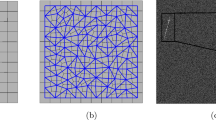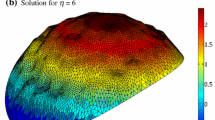Abstract
The study of wave propagation in finite/infinite media has many applications in geotechnical and structural earthquake engineering and has been a focus of research for the past few decades. This paper presents an analysis of 2D antiplane problems (Love waves) and 2D in-plane problems (Rayleigh waves) in the frequency domain in media consisting of a near-field irregular and a far-field regular part. The near field part may contain structures and its boundaries with the far-field can be of any shape. In this study, the irregular boundaries of the near-field are treated as consistent boundaries, extending the concept of Lysmer’s vertical consistent boundaries. The presented technique is called the Condensed Hyperelements Method (CHM). In this method, the irregular boundary is limited to a vertical boundary at each end that is a consistent boundary at the far-field side. Between the two ends, the medium is discretized with hyperelements. Using static condensation, the stiffness matrix of the far-field is derived for the nodes on the irregular boundary. Examples of the application of the CHM illustrate its excellent accuracy and efficiency.
Similar content being viewed by others
References
Aki K and Larner KL (1970), “Surface Motion of a Layered Medium Having an Irregular Interface due to Incident Plane SH Waves,” Journal of Geophysics, 75: 933–954.
Bouchon M and Compillo M (1989), “Boundary Integral Equation Discrete Wave Number Response Method to Study Wave Propagation in Multi-layered Media Having Irregular Interfaces,” Geophysics, 54: 1134–1140.
Bouchon MA (1985), “A Simple Complete Numerical Solution to the Problem of Diffraction of SH Waves by an Irregular Surface,” Journal of Acoustic Society of America, 177: 1–5.
Dorafshan S (2011), Developing Condensed Hyperelements Method (CHM) for Calculation of Green’s Functions in Irregular Media, Department of Civil Engineering, Isfahan University of Technology, Esfahan, Iran.
Hadley P (1991), Explicit Integration of Boundary Integral Equation in Frequency Domain for Wave Scattering Problems, Recent Applications in Computational Mechanics: New Orleans.
Ikeda Junior I (2008), Analysis of Wave Motion in Irregular Layered Media Using a Finite Element Perturbation Method, Faculty of Graduate School of The University of Texas at Austin, Doctor of Philosophy Dissertation, Texas.
Kausel E (1974), “Forced Vibrations of Circular Foundations in Layered Media,” MIT Research Report 70-3, Department of Civil Engineering, Massachusetts Institute of Technology, Cambridge. M.A.
Kausel E (1994), “Thin Layer Method Formulation in Time Domain,” International Journal of Numerical Methods in Engineering,37: 927–941.
Kausel E and Roesset JM (1977), “Semi-analytic Hyperelement for Layered Strata,” Journal of Engineering Mechanics Division, EM, 4: 569–688.
Kawase H (1988), “Time Domain Response of Semicircular Canyons for Incident SV, P and Rayleigh Waves Calculated by the Discrete Wave-number Boundary Elements Method,” BSSA, 78: 1415–1437.
Khamesipour A (2006), Analyzing Love Wave Propagation in Infinite Medium with Arbitrary Lateral Boundaries by Thin Layer Method, Faculty of Civil Engineering of Isfahan University of Technology, Esfahan, Iran.
Lee VW and Wu X (1994), “Application of Weighted Residual Method to Diffraction by 2D Canyons for Arbitrary Shape II: Incident of P, SV and Rayleigh Waves,” Soil Dynamics and Earthquake Engineering, 13: 365–375.
Lysmer J (1970), “Lumped Mass Method for Rayleigh Waves,” BSSA, 60: 89–104.
Lysmer J and Drake LA (1972), A Finite Element Method for Seismology, Dept. of Civil Engineering University of California, Berkley, California.
Lysmer J and Kuhlemeyer RL (1969), “Finite Dynamic Model for Infinite Media,” Journal of Engineering Mechanics Division, EM, 4: 859–877.
Moeen-Vaziri N and Trifunac MD (1988), “Scattering and Diffraction of Plane P and SV Waves by Two Dimensional Inhomogeneities, Part II,” Soil Dynamic and Earthquake Engineering, 7: 189–200.
Nagano M and Motosaka M (1995), “Response Analysis of 2-D Structure Subjected to Obliquely Incident Wave with Arbitrary Horizontal Angles,” Journal of Structural and construction engineering, Transactions of AIJ, 476: 67–76.
Nagano M and Motosaka M (1996), “Dynamic Soil Structure Interaction Analysis of a Structure Embedded in an Irregularly Layered Soil Using Axi-symmetric Hyperelements,” Journal of structural and construction Engineering, Transactions of AIJ, 490: 81–90.
Nikolos IK and Delis AI (2009), “An Unstructured Node-centered Finite Volume Scheme for Shallow Water Flows with Wet/dry Fronts over Complex Topography,” Computer Methods in Applied Mechanics and Engineering, 198: 3723–3750.
Park SH and Tassoulas JL (2002), “Time-harmonic Analysis of Wave Propagation in Unbounded Strata with Zigzag Boundary,” Journal of Engineering Mechanics, 128: 359–368.
Piron R, Ballereau P and Canud B (2009), “Shock Propagation along a Two-layer Interface in Confined Geometry,” European Journal of Mechanics-B/Fluids, 28: 613–618.
Reisono E, Wrobel LC and Power H (1997), “Three Dimensional Scattering Seismic Waves from Topographical Structures,” Soil Dynamics and Earthquake Engineering, 16: 44–61.
Sanchez Sesma FJ (1983), “Diffraction of Elastic Waves by Three-dimensional Surface Irregularities,” BSSA, 73: 1621–1636.
Sanchez Sesma FJ and Esquivel JA (1979), “Ground Motion on Alluvial Valleys under Incident Plane SH Wave,” BSSA, 69: 1107–1120.
Sanchez Sesma FJ, Pérez-Rocha LE and Chávez-Pérez S (1985), “Diffraction of Elastic Waves by Three-Dimensional Surface Irregularities: Part II,” BSSA, 79: 101–112.
Santos P and Tadeu A (2004), “Scattering of Seismic Waves Generated by an Irregular Seabed,” Computers and Structures, 82: 1791–1804.
Tadeue AJB, Kausel E and Vrettos Ch (1996), “Scattering of Wave by Subterranean Structures via Boundary Element Method,” Soil Dynamics and Earthquake Engineering, 15: 387–397.
Vai R, Castillo-Covarrubias JM, Sánchez Sesmaa FJ, Komatitschc D and Vilotte JP (1999), “Elastic Wave Propagation in an Irregularly Layered Medium,” Soil Dynamics and Earthquake Engineering, 18: 11–18.
Wang Ch (2010), “Direct and Inverse Solutions with Non-fourier Effect on the Irregular Shape,” International Journal of Heat and Mass Transfer, 53: 2685–2693.
Wong HL (1982), “Effect of Surface Topography on the Diffraction of P, SV, and Rayleigh Waves,” BSSA, 72: 1167–1183.
Young DL and Fan CM (2009), “The Time Marching Method of Fundamental Solutions for Wave Equations,” Engineering Analysis with Boundary Element, 33: 1411–1425.
Author information
Authors and Affiliations
Corresponding author
Rights and permissions
About this article
Cite this article
Dorafshan, S., Behnamfar, F., Khamesipour, A. et al. Condensed hyperelements method of non-vertical consistent boundaries for wave propagation analysis in irregular media. Earthq. Eng. Eng. Vib. 12, 547–559 (2013). https://doi.org/10.1007/s11803-013-0196-7
Received:
Accepted:
Published:
Issue Date:
DOI: https://doi.org/10.1007/s11803-013-0196-7




